A trip to Niue (via BNE-AKL-IUE-AKL-DXB-BNE)
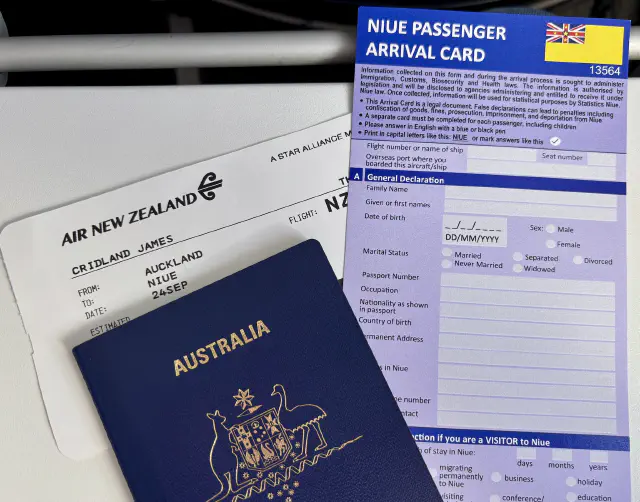
This trip promises to be something a little different - a new country to visit (the little Pacific Island of Niue); a relatively new airline to fly (Air New Zealand, which I haven’t flown since before the pandemic); and a new Emirates class, premium economy. And a lot of random flying about.
My trip starts with a lot of random driving about, as my Uber driver gets lost on the way to the airport. And then at the actual airport. An Uber driver who doesn’t know where to drop someone off at the airport. WT actual F.
The airport is quiet, and even though I have no status on NZ, there wasn’t much queuing.
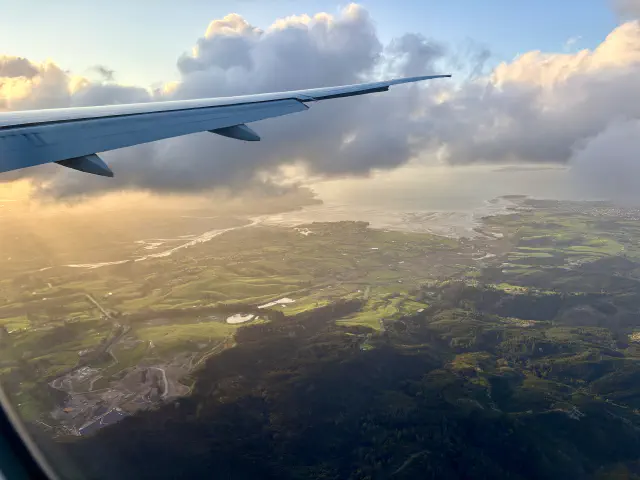
An uneventful flight to Auckland (though doesn’t New Zealand, seen above, look pretty from the air? So lush! So green!) I was booked into the Novotel, but the Novotel wanted to take us to the Pullman next door, so, go on then, let’s do that. It seemed brand new. I ate in the food court of the airport though because I’m not made of money.
The next morning, we couldn’t check in on the app (“checkin has closed” was the slightly worrying message), and instead there was a big queue on a manual-looking line to check in. The big queue goes relatively quickly, though, and we’re onto the plane. Air New Zealand offers free wifi, like Qantas flights do domestically, but unlike Qantas, the wifi on Air New Zealand is rubbish and entirely unusable.
Niue
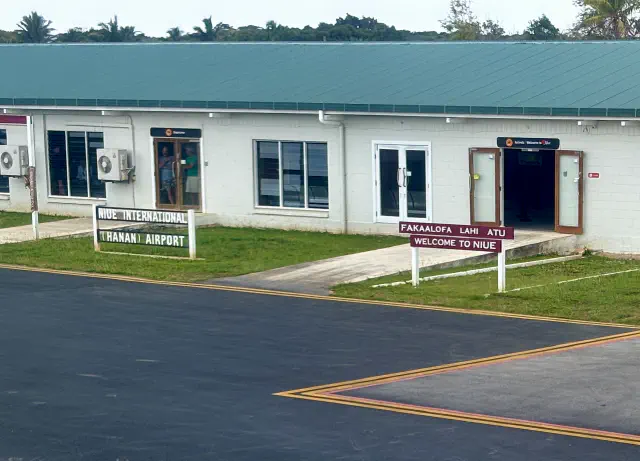
There are two flights a week to Niue. This is one of them. We land in the little Niue airport. It has some very photogenic signs in front of it that I’m sternly told I may not take photographs of (so a good job I did from the plane).
Niue. It’s pronounced “New-ae”. It’s a small, remote island in the Pacific that has been self-governing for exactly fifty years. It’s part of the Realm of New Zealand, so they use New Zealand dollars on the island, and the people have a New Zealand passport.

On an excursion, we get to watch a languorous documentary in the Niue Museum, made just before the self-governing referendum fifty years ago. The 1974 documentary showed an island rather more populated and prosperous-looking than today. The population was 3,992 in 1974, down from 4,990 in 1971. A wiry man with a half-moustache was interviewed for the film (22 minutes in), who was returning from education in New Zealand. Erudite, confident and eager, he says that he has no worries if the population falls. “We can carry on quite comfortably with, say, 3,500 people”, he adds with certainty. “I think if the population drops to about 2,000 then we need to get a bit worried,” he adds.
We recognise the man. After a successful media career, Hima Douglas is now the unopposed speaker of parliament. He gave an excellent speech earlier in the conference. And we saw him again in Parliament, where he explained how Parliament on the island worked. He’s a good natured, interesting man, still sporting the same moustache, long since greyed with age.
The population of the island is now 1,600.
We make our way to the island’s only hotel, perched over the ocean; and for an opening party in a nearby village - with coconut crabs, or “uga”, the focus of the lavish meal in the grounds of a former school. All education on the island has moved to the main village, Alofi (Al-oh-fi), and the island is littered with derelict school buildings, looking out on empty squares of grass. There are speeches from the Prime Minister, the Speaker, and others.
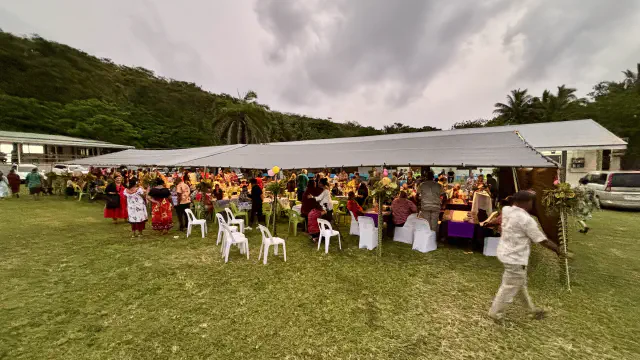
Later, in a press conference (below), the Prime Minister, Dalton Tagelagi, gets irritated at being asked about the population numbers. They are not falling, he claimed, and anyway, it’s the young people, they should be making more babies.
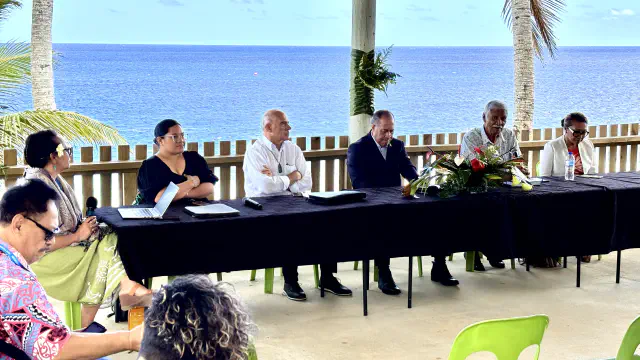
Niue, which seems to have good reliable electricity, could do well to benefit from remote working. Telecom Niue covers some of the island with a 4G signal; but I didn’t find a single good wifi connection, and I suspect the hotel’s was just a (badly overloaded) 4G hotspot. Starlink is illegal here - to protect Niue’s own telecom company, one suspects (and that’s probably a good thing). I bought a Telecom Niue SIM card, for $55, which came with 6GB of data - just the right amount for my stay, it turned out: including some podcast production. That seemed reliable, at least.
The reality is that Niue is dependent on the aid it gets from New Zealand, Australia and other places. The roads in Niue are all in excellent condition - newly laid, paid-for by the Chinese government. It was a controversial decision; but it wasn’t a loan, the Niuean Government was keen to point out, it was just aid. And at every junction, you’re reminded of who paid - a thing looking like a gravestone with the words “China Aid” on it.
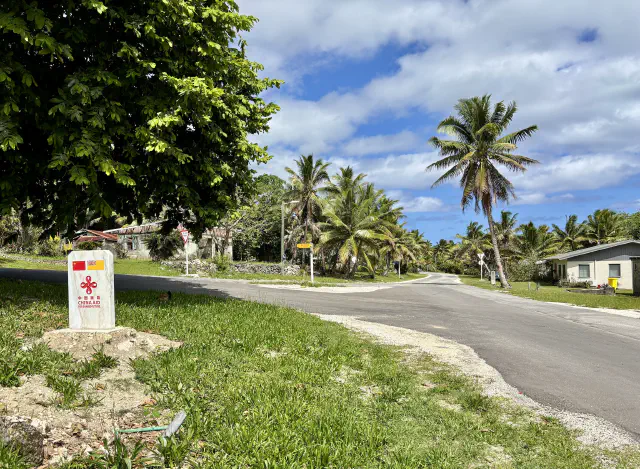
There are more Niueans in New Zealand than at home in Niue. It’s hard to see the attraction for them to return home - other, perhaps, that it is home. Every village on the island, while kept immaculately tidy and clean, with grass mowed, has a number of empty and abandoned houses.

We had an excellent welcome, and were looked after very well. On the last day, I checked in my bag at 9.15am in the airport - and was then invited by colleagues to join them for a drive and walk to an impressive beach, the Togo Chasm. A small track, about a kilometre long, snaked through the tropical forest to suddenly reveal a seascape quite unlike any other - a limestone formation that looks very other-worldly.

We drove back through quiet villages and stopped off in Alofi before going back to the airport to wait for our plane. Waiting outside was the host of the event, with an embroidered polo shirt for each of us to say goodbye. I told you they looked after us well.
Captain Buck Rogers flew us to Auckland. I’m almost convinced he made that name up. The first flight I took to America was flown by Captain Dangerfield. Maybe it’s a prank by airline staff to see if we notice.
Our flight was late to take off - and late to land; about 40 minutes late, which gave me quite a bit of concern. I needed to get my bag, then come into New Zealand through the long passport queue, then run to the Emirates checkin desk, check my bag in again, and go through security once more. My bag was, predictably, one of the last out; and, also predictably, our flight came in just after a flight from China. It was a nerve-wracking trip through the airport, and I was one of the last to check in to the flight. But I made it, and found my way to the lounge and a welcome cold drink.
So, to the longest flight possible on Emirates - 14,200 km, and an average of 16 hours 22 minutes. My client for this journey has kindly given me Premium Economy, which I’ve not flown on Emirates (not least, the Brisbane aeroplane doesn’t offer it).
The Premium Economy seats are spacious, and I think they lean back further. I’m in a middle seat, thanks to my ticket being booked panic-inducingly late. And as far as I can see, the seats are the main benefit; PE customers also get a drink when taking off (orange or lemon mint). Surprisingly, they don’t get a different amenities pack. The food is fine (I guess it’s a different menu, and it’s served on crockery not plastic/foil trays). I sleep for most of the way - with a new Trtl sleeping pillow, which was a good investment - only waking up when breakfast was being served.
16 hours 41 minutes later, we arrive 24 minutes early.
Dubai
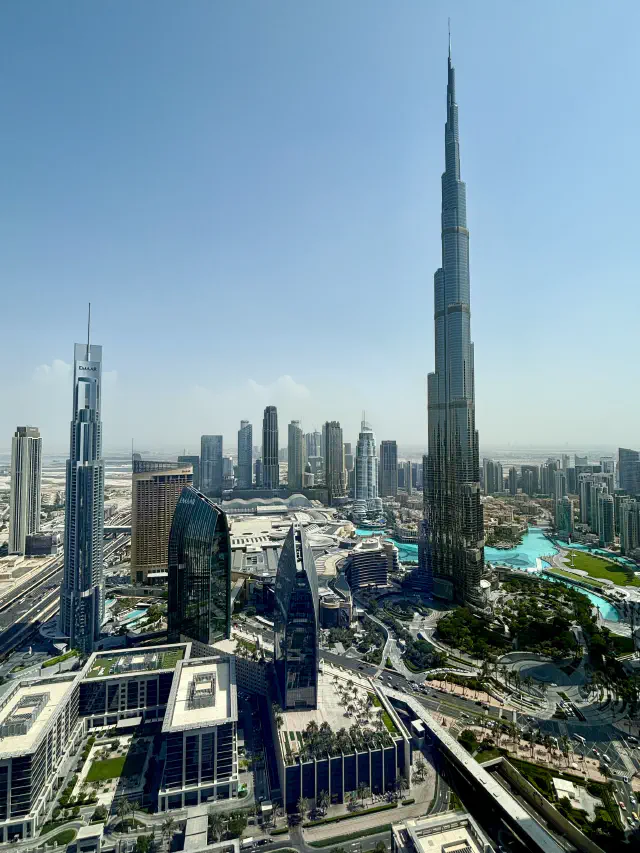
Dubai has changed a lot since I visited in 2007. It has had an almost manic growth since - now with a decent metro (with a special gold carriage, which you pay extra for, which I’m told is often more full than the rest of the train).
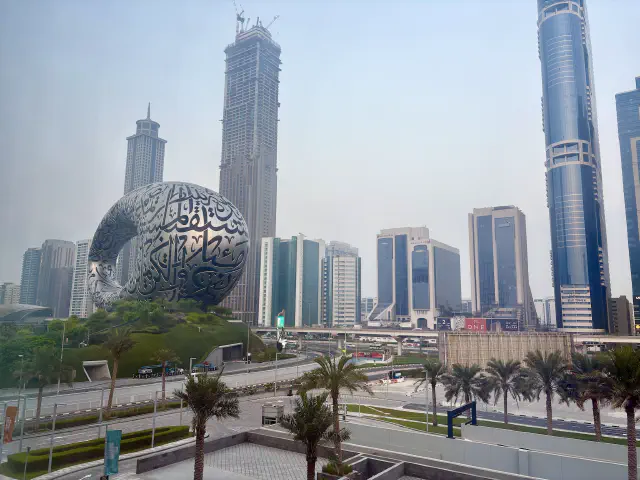
I try the Dubai Mall, and a “sky view”, and this incredible piece of architecture: the Museum of the Future - an amazing building, but disappointingly, the museum bit is pointless bling and has no academic or thoughtful basis to any of its exhibits - just showing off that they can make big TV screens and CGI. It was $60 (US) to go round. Save your money - you’ll get just as good an architectural experience by just visiting the entrance hall. And if you’re staying in the same hotel as I was, directly opposite it over the road, you can also have the intellectual stimulation of trying to work out how to walk there. It is possible, but it involves a tiny and entirely unmarked gate in an otherwise impenetrable fence. And a hotel concierge who thinks you’re mad to even want to try.
Back to the airport, discovering that there is an entirely separate doorway for Business and First, which is fine for Qantas Platinums. I am the only person checking in. It is deathly quiet for my 0230 flight (I get to the airport at 9.45).
I’m only in economy on the way back to Brisbane - there’s no premium economy on this plane. I squeeze into the middle seat once more. I’ll need a miracle to get through this flight, I think to myself, as the flight attendant moves towards me, greeting me by name. This is an early Platinum welcome, I think. But no. “This flight was going to be full, but now it is going to be mostly empty due to…” She pauses slightly, choosing her words carefully. “…some tensions in the region.”
So, I move a row back, next to the window, which is otherwise entirely empty. Thank you, Israel, for your disappointing and entirely unnecessary attempt to start World War III, but due to your missiles currently raining down on Iran (and Lebanon, and Gaza), it sounds as if quite a few flights were cancelled, so the remaining EK430 passengers are the beneficiary. Benjamin Netanyahu, this is possibly not what you were trying to achieve, but I will appreciate my econobed this morning, and for that I guess I’m grateful, if not the other bits.
We are slightly delayed “due to the geo-political situation”, too. But, after Andi Peters shouts at us about all the amazing things you can do on the inflight entertainment system, we’re off, 25 minutes late.
As we land, the flight attendant comes up to me, to greet me by name again, and ask if I have any feedback on the flight. I do - to her surprise. This flight starts with breakfast (and therefore no alcohol), so if you have a cheeky glass of wine to send you to sleep, that’s not going to work. And the main meal is after you wake up, where there is alcohol available, but I don’t want to be drinking beer just before I land, thanks. I express surprise at this arrangement. She thanks me for my feedback, and regrets asking.
We land just 2 minutes late; and Brisbane airport is empty and decent. Home. For a short time. But home.